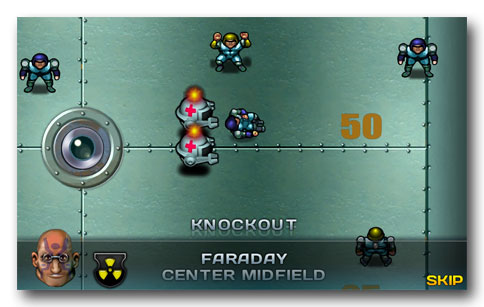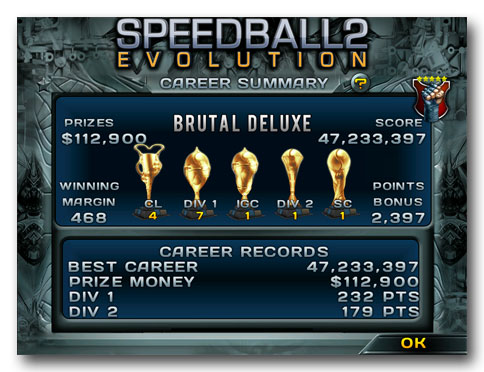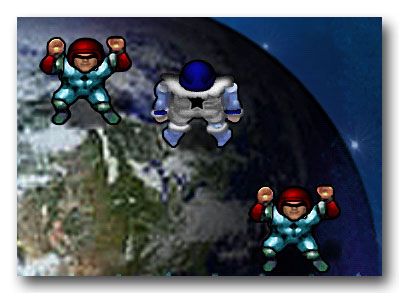The Atari ST is almost a forgotten machine these days, unsurprising since it was primarily popular in Europe, and both gamer and media attention is usually focused with laser intensity on the American and Japanese gaming scenes to the exclusion of all else. A full-fledged personal computer whose stand-out feature was its affordability, the Atari ST was a fine gaming machine for its time and many a talented game developer worked on it including Peter Molyneux, David Jones, Jez San and, of course, the Bitmap Brothers.
The Bitmap Brothers not only took the EA “developer as artist” credo to heart, they pushed it further to become self-described rock star developers complete with sunglasses, leather jackets and cocksure attitudes. They were perhaps a tad overrated and it’s telling that, unlike their notable peers of the era, the Bitmap Brothers had trouble transitioning out of the Motorola 68000 game space. (The PC version of their 1993 game, The Chaos Engine, was excoriated in Computer Gaming World with “Gamers wishing they could turn their Pentium into a Super Nintendo so they can play a home video rip-off of some 1980 arcade hit need look no further …”) Their arcade-inspired games were enjoyable and had some neat ideas but they weren’t especially innovative. Yet when the Bitmap Brothers did think outside the box, they did manage to come up with one of the best two-player games of the early 90s.
Lethal Formula
Speedball 2: Brutal Deluxe was an outstanding sequel to a decent game. It took all the ideas that made the original Speedball stand out and added a whole lot of swagger, bombast and rock star flair to the mix to create a gleefully over-the-top celebration of gladiatorial competition.

Speedball 2 sees two teams of nine competing in a brutal futuristic sport combining football’s pace and American football’s off-the-ball aggression. If the concept seems vaguely familiar, it’s likely the game’s British developers would have had in mind the various 2000AD strips inspired by the 1975 movie Rollerball (YouTube, 04:16). In turning a sketchy faux-sport into an actual game, the Bitmap Brothers ingeniously set the action on a playing field resembling a pinball machine (complete with multiplier ramps, bumpers and bonus targets), and to increase the levels of unpredictability, there were videogame power-ups scattered around that could dramatically (albeit briefly) affect play.
The end result is a game that encourages both ferocity and silky skill with points being awarded for brutalising opponents, scoring goals and hitting targets. It is a lot more tactical than it first appears and winning often requires plans more cunning than rushing directly towards the opposing goalmouth with the ball. When facing superior opposition, the player must resort to slyness and skill rather than brute force — perhaps hurling the ball at the electrobounce target from angles precisely calculated to score undefendable goals, perhaps exploiting bonus point opportunities and running down the clock rather than risking everything for a goal.

On the Atari ST, it was the perfect two-player game, inspiring frenzied gaming sessions filled with hollering and laughter in equal measure. This is a game that lets accomplished players to viciously torture opponents over the course of 180 seconds, racking up three digit scores in the process.
There have been a few attempts to resurrect Speedball 2 over the years with the latest being for the iPad. The credits prominently list Tower Studios, headed by a former member of Sensible Software, but it appears the company is nothing more than a procurer of old licenses which it farms out to other studios for projects. The actual developer of Speedball 2 Evolution is a Polish studio, Vivid Games, as can be discerned from the paucity of vowels in the game’s credits. They’ve done a commendable job remaking the game given the limitations of the platform.
They should be faulted for not showing much in the way of ambition, however. What few additions this new version has are scarcely worthy of the term “evolution,” being either predictable (Achievements, social one-upmanship features) or exploitative shortcuts (microtransactions to purchase in-game cash).
Mean Machine
There are two control options available on the iPad and neither feels fully satisfactory. The experience would have been much improved even with a simple 33-year-old Atari joystick (a mighty device that would nonetheless reliably break during intense two-player Speedball 2 sessions) but then portable gaming is fundamentally about compromise.
Gamers who played Speedball 2 with a joystick back in the day will undoubtedly opt for the virtual joystick — an unimaginative way to translate the original game’s controls for a touch-sensitive tablet. The virtual joystick feels sluggish and imprecise, complicating efforts to make mazy runs to avoid tackles.
The second method is to use tilt control and it is the superior option even if it leaves the player looking like an Etch A Sketch artist with delirium tremens. Speedball 2 veterans may find this weird control scheme initially offputting as tackling requires tracking the opponent with the ball while simultaneously tilting the screen at different angles to intercept. (To simulate how awkward this feels on a desktop computer, have someone tilt the monitor this way and that while playing an arcade game.) The key to getting the most out of tilt control is to ensure proper calibration. The game calibrates at the start of each match and if the controls feel off, the player may recalibrate after pausing the game.

Rage 2000
It’s hard to determine whether this classic game can find a new audience. Gamers who never encountered Speedball 2 in its glory days might not be able to get past the stark presentation and the general iOS gaming audience cultivated to expect simple and disposable experiences is going to steer clear of this.
(If the Game Center statistics are an accurate indicator, Speedball 2 Evolution players number less than 31,000 worldwide which means anyone hoping to get some two-player action via local bluetooth and wifi will be disappointed.)
Speedball 2 Evolution is primarily for those with fond memories of the original and for those players, revisiting the game is enjoyable enough once they’re accustomed to the new controls. There are a few changes here and there (for instance, the management-only option and the comic style pop-up panels to celebrate goals and highlight injuries have been omitted) but nothing that detracts too much from the experience.
The problem is gamers who first experienced Speedball 2 in its Atari ST or Amiga incarnations two decades ago would have evolved their tastes since then, leaving them disappointed that this version hasn’t been improved in meaningful ways. Even back then, the game’s management elements were outshone by contemporaneous titles such as Anco’s fantastic Player Manager.
As things stand, the management aspect of the game’s Career mode eventually becomes irrelevant as players will have completely updated their team roster well before the 10-season time limit runs out. Once that happens, the challenge level in the league drops tremendously and hapless AI opponents will be routinely defeated by 200 points or more. Players looking for a real test of skill should opt instead for Challenge mode with Champions League-level AI opponents.

Super Nashwan
Playing Speedball 2 Evolution lays bare the old truth once again: revisiting an old love for a brief spell provides some pleasure; staying longer only serves to bring to mind the reasons for leaving it behind. Gaming has moved on since 1990 and, aside from those stuck in the past perpetually glorifying childhood favourites, so have gamers.
The frustrating thing is Speedball 2’s core ideas are sound; the design simply needs to be enhanced, expanded and adapted for the current generation. This iteration could have been a real triumph if the developers had, say, added a career mode with more depth, better player management and greater role-playing elements a la Sports Interactive’s Football Manager franchise. Of course, it wouldn’t be Speedball 2 at that point and it certainly wouldn’t have been a game suitable for the general iOS audience but the point remains, this isn’t an evolution; it’s merely exploitation representative of the gold rush mentality pervasive in iOS game development.
The Speedball 2 design deserves a lot better than this rehash and when some developer cognisant of that delivers a true evolution, fans and gamers in general will have a real reason to lift their faces to the heavens, raise their fists and vigorously shake their thighs from side to side in celebration.

